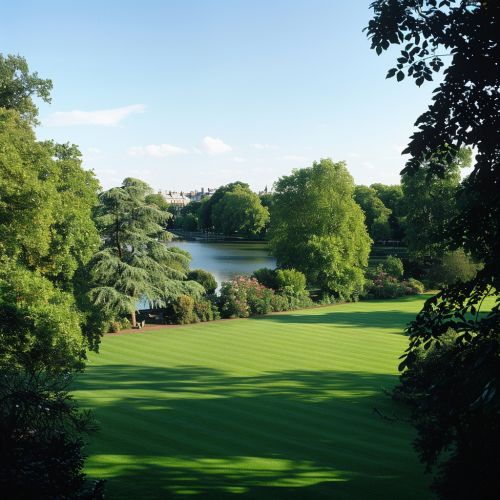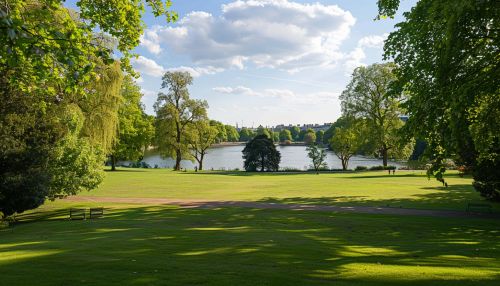Regent's Park
History
Regent's Park, located in the northern part of central London, is one of the Royal Parks of London. The park spans an area of 410 acres and is known for its meticulously landscaped gardens, sports facilities, and cultural attractions. The park's history dates back to the early 19th century when it was designed by the renowned architect John Nash under the patronage of the Prince Regent, who later became King George IV.
The land that now constitutes Regent's Park was originally part of the manor of Tyburn, which was owned by Barking Abbey. Following the dissolution of the monasteries under Henry VIII, the land was seized by the Crown and used as a hunting ground. In 1811, the Prince Regent commissioned Nash to develop the area into a public park and residential area, leading to the creation of the iconic terraces and villas that surround the park today.
Design and Layout
The design of Regent's Park is a testament to Nash's vision of combining natural beauty with urban functionality. The park is divided into several distinct areas, each with its own unique features. The Inner Circle, located at the heart of the park, houses the Queen Mary's Gardens, which are renowned for their stunning rose displays. Surrounding the Inner Circle are the Outer Circle and the park's various sports facilities, including the famous Lord's Cricket Ground.


The park also features several lakes and waterways, which were designed to enhance the park's aesthetic appeal and provide habitats for various species of wildlife. The Boating Lake, located in the northern part of the park, is a popular spot for recreational activities such as rowing and pedal boating.
Flora and Fauna
Regent's Park is home to a diverse array of flora and fauna, making it a haven for nature enthusiasts. The park's gardens boast a wide variety of plant species, including rare and exotic specimens. The Queen Mary's Gardens, in particular, are famous for their collection of over 12,000 roses, representing more than 85 different varieties.
The park's wildlife is equally impressive, with numerous species of birds, mammals, and insects inhabiting its grounds. The Regent's Park Open Air Theatre and the surrounding woodlands provide a habitat for several species of bats, while the park's lakes and ponds are home to waterfowl such as swans, ducks, and herons.
Attractions and Facilities
Regent's Park offers a wide range of attractions and facilities for visitors of all ages. The Zoological Society of London (ZSL) London Zoo, located in the northern part of the park, is one of the world's oldest and most famous zoos. Established in 1828, the zoo houses a vast collection of animals from around the globe and is actively involved in conservation and research efforts.
The park also features several sports facilities, including tennis courts, football pitches, and a running track. The Regent's Park Sports Hub, located near the Outer Circle, offers a variety of fitness classes and activities for visitors. Additionally, the park's open spaces and scenic pathways make it an ideal location for jogging, cycling, and picnicking.
Cultural Significance
Regent's Park has played a significant role in London's cultural and social life since its inception. The park's picturesque landscapes and architectural landmarks have made it a popular setting for various events and activities. The Regent's Park Open Air Theatre, established in 1932, is one of the park's most iconic cultural institutions. The theatre hosts a diverse program of performances, ranging from classic plays to contemporary productions, attracting audiences from across the city and beyond.
The park is also home to several annual events and festivals, including the Frieze Art Fair, which showcases contemporary art from leading galleries around the world. The park's bandstands and open spaces frequently host concerts, community events, and seasonal celebrations, further enhancing its role as a vibrant cultural hub.
Conservation and Sustainability
Regent's Park is committed to promoting conservation and sustainability through various initiatives and programs. The park's management works closely with environmental organizations and local communities to preserve its natural habitats and promote biodiversity. Efforts to reduce the park's carbon footprint include the use of renewable energy sources, sustainable landscaping practices, and waste reduction measures.
The park's educational programs aim to raise awareness about environmental issues and encourage visitors to adopt sustainable practices. These programs include guided nature walks, wildlife workshops, and interactive exhibits at the London Zoo. The park's commitment to conservation and sustainability ensures that it remains a cherished green space for future generations to enjoy.
Accessibility and Visitor Information
Regent's Park is easily accessible by public transportation, with several London Underground stations located nearby, including Baker Street, Regent's Park, and Great Portland Street. The park is open to the public year-round, with varying hours depending on the season. Admission to the park is free, although some attractions and facilities, such as the London Zoo and the Open Air Theatre, may require tickets.
The park offers a range of amenities to enhance the visitor experience, including cafes, restrooms, and information centers. Accessibility features, such as wheelchair-friendly pathways and designated parking spaces, ensure that all visitors can enjoy the park's attractions and facilities.
